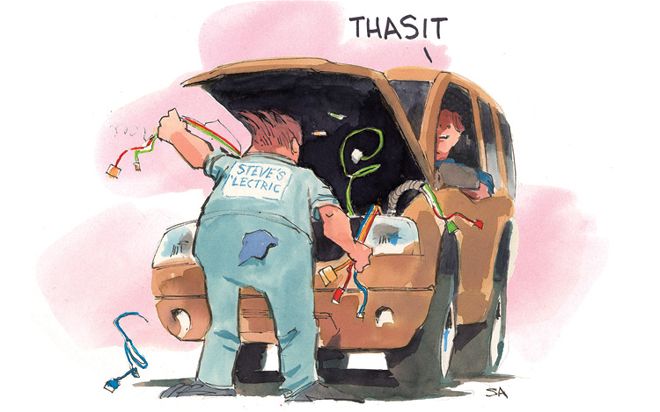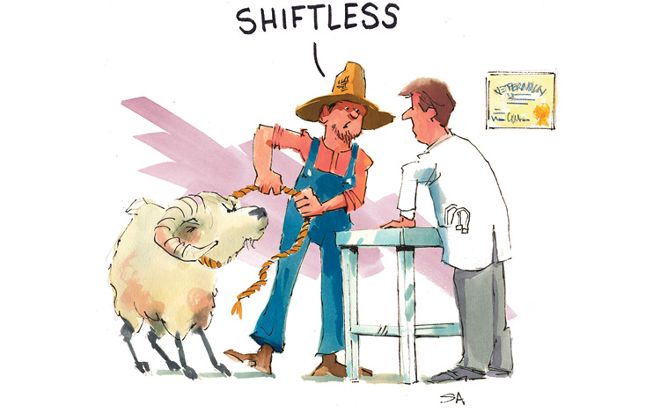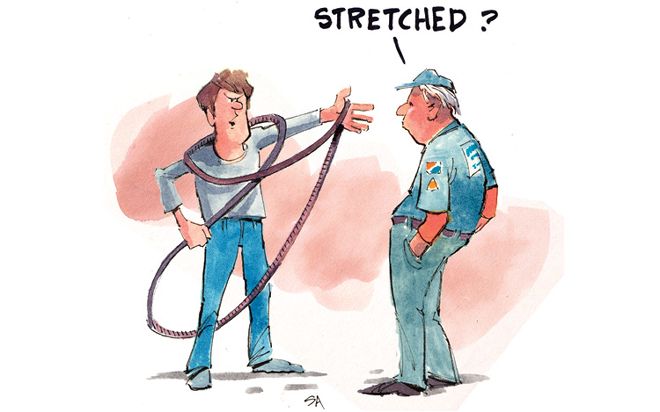
| expert Advice cartoon Mechanic
Troublesome Airbag Light
Q: The battery went dead on my 1996 Ford Explorer without any warning. Since then, the airbag light won't go out. I unhooked the battery for an hour then hooked it back up to recycle it, but it still comes back on. Any ideas?
A: During normal operation, the airbag indicator will light up when the ignition is switched from "Off" to "Run", and then go out after about six seconds. If a fault exists, the indicator won't come on at all, will remain lit continuously, or will begin flashing after 30 seconds to indicate trouble codes stored in the system's memory. Accurately scanning and diagnosing the system requires the appropriate service information and the correct scan tool, in this case, a New Generation Star tester or equivalent. It may be coincidental that the indicator light came on after losing battery voltage. But it shouldn't be a "reboot" situation-there's a fault in the system that requires repair. I'd suggest getting it to a trained technician at a Ford service department. And keep in mind the dangers of accidental airbag deployment before attempting any repairs on your own.

| expert Advice dodge Ram Wont Shift
My Ram Won't Shift
Q: I have a 1998 Dodge Dakota 2WD with an automatic transmission that won't upshift. It stays in first gear. Even under wide-open throttle the rpm will climb all the way to redline without shifting. I only have first gear and Reverse. Also, when I put the truck into Reverse from Park, there's a buzzing/whirring noise that lasts about two seconds and then goes away. But there are never grinding noises. The truck has roughly 55,000 miles and has been serviced twice so far using exclusively Mopar ATF+4 transmission fluid. I suspect the governor pressure sensor and/or solenoid might be the problem.
A: The governor valve allows the powertrain control module, after analyzing relevant data, to regulate the transmission's hydraulic pressures and efficiently control shifting. Proper diagnosis is going to require a road test, a scan tool, and a hydraulic pressure gauge. Top-three possible causes for a good first gear and Reverse, but no 1-2 or 2-3 upshift, are a governor-circuit electrical fault, a valve-body malfunction, or a damaged or burned kickdown servo or band. Your hunch on a governor pressure problem is indeed plausible, but I wouldn't invest any money prior to verification by a technician. Odds are in your favor, but the problem could be a more extensive internal breakdown that may require overhaul or replacement. Figuring it out should be straightforward for a transmission technician.
Searching for Servos
Q: In a previous column you answered a question regarding a cruise-control kit for a 2004 Jeep Wrangler. It stipulated you had to have a certain "servo connector" for it to work. Could you please tell me how to find out whether or not my Jeep has this connector?
A: Regardless of the engine, 2.4-liter four-cylinder or 4.0-liter inline-six, the cruise-control servo is mounted under the hood and on top of the left fenderwell. The cruise-control servo is basically a vacuum diaphragm that opens and closes the throttle by means of a cable. Search near the fenderwell and in front of the master cylinder for a black four-wire connector. It should have black, tan, light-green, and dark-blue wires coming out the back, all with red stripes except for the black one. Keep in mind that unused connectors can be well hidden. You also can call a local Jeep service department, with your vehicle identification number handy, and ask them to look up the build date of your particular Wrangler. If it falls between 3/20/03 and 3/12/04, the wiring harness needed for installation of the Mopar speed-control system was not installed at the factory. There also may be a Jeep technician you can speak with at the service department, experienced in the system's installation, who might be of further help.
Leaky Custom Wheels
Q: I have a 2003 Ford F-450 pickup with 225R/19.5 tires and six-inch-wide rims that came on the truck. I wanted to put on 285R tires. That's where my problems began. The tire manufacturer recommends that 285R tires go on a 7.5- to 9.0-inch-wide rim, but I couldn't find a company that sold 19.5-inch rims wider than six inches. So I had a local wheel modifier widen my rims to eight inches. That worked until I put a 6000-pound camper on the truck: Now, the left rear tire keeps losing air. It's seeping out of the rim's outer weld. The wheel modifier tried to repair it twice. Every time I take it on a trip the tire goes flat in two or three days. As I see it, the only way to eliminate the problem is to get the right size rims. I've spent the better part of two months checking with truck tire companies, to no avail. I'm afraid the welds are cracked, and the rim could come apart. I would hate for that to happen with the camper on board at turnpike speeds.
A: You should be concerned about riding on made-to-order rims with a potentially dangerous substandard weld. Wheel disintegration while driving a commercial-grade truck is something to avoid whenever possible. And I'm not quite sure what you're trying to achieve by installing bigger tires and wheels. The 2003 Ford F-450 specification chart shows 225/70R19.5 as the factory installed tire size. My guess is that you've installed larger tires that were meant for a higher weight class commercial truck, and you couldn't find wide enough 19.5-inch rims to accommodate these tires because they don't make that wheel with the lug pattern necessary for an F-450. If that's the case, I don't see the advantage, since bigger isn't always better. My only suggestion is to reinstall the original wheels with a new set of the manufacturer-recommended-size tires. There's a Bridgestone/Firestone-sponsored Web site that specializes in commercial truck tires-visit www.trucktires.com. It's loaded with information and a "Tire Doctor" page to submit questions. You might want to run your dilemma by their experts.

| expert Advice stretched Belt Cartoon
Squeaky Belt Syndrome
Q: I have a 2001 Ford Ranger with the 4.0-liter SOHC V-6. It has a continuous squeaking noise coming from under the hood. This only seems audible when it's idling. I've had problems in the past where the noise becomes intrusive at faster speeds. I had the timing belt replaced several times and that seems to work for about six months, but then the noise comes back.
A: Ford's 4.0-liter V-6 engine uses a timing chain, not a belt, that connects the crankshaft with the camshafts. You're referring to the serpentine belt that drives engine accessories, such as the water pump, alternator, power steering pump, A/C compressor, and so on. Instead of using an individual belt for each accessory, the serpentine drive belt wraps back and forth around all the accessory pulleys and turns everything in unison with engine rotation. There's typically an adjustable or spring-loaded tensioner that maintains belt tension. And there are some basic areas you should check. Be sure all accessories are in good condition and not binding or partially seized. Also, check the belt for signs of contamination by a fluid, such as power-steering fluid leaking directly on the belt. Get the tensioner tested to ensure it's keeping the belt taut to specifications, and have the tensioner pulley checked to be sure its bearing isn't loose or binding. Last, but not least, all pulleys should be inspected for bends, cracks, and proper alignment. One pulley that's not lined up quite right with the others is a common cause of repeat drive-belt noise and failure. This may also be evident by abnormal sideways wear at the belt's ribs and grooves.
Pads and Rotors
Q: I did a brake job on my 2002 Ranger, replacing the front brake pads and inspecting each rotor. They didn't look bad, but I know there are probably situations when you need to have them turned. How often should you have the rotors either turned or replaced?
A: If you're replacing worn-out brake pads, it's time to resurface the rotors; otherwise, the new pads may not perform at their highest level, and you may develop a brake pulsation in a short period of time. That's when you end up doing the job all over again. As far as inspection, and when rotors should be replaced, the answer is cast into the rotor where it reads "Minimum Thickness." In your case, the minimum rotor thickness is 1.023 inches. After removing a rotor, measure the thickness with a micrometer. If it's past its minimum thickness, or is close and may be too thin after resurfacing, replace both rotors with new ones. Drum brakes involve different parts and tools, but the same basic principles apply.
How To Reach AlexIf you have a technical question regarding your pickup, SUV, or van, feel free to contact Alex, a master technician with the National Institute for Automotive Service Excellence. Send a letter to him in care of Truck Trend Garage, 831 S. Douglas Street, El Segundo, CA 90245, or e-mail us at trucktrend@sourceinterlink.com. Please include the VIN with your question. Due to the volume of questions received every month, we cannot guarantee that everyone's question will be personally answered or will appear in the magazine.
Can't wait for help with a problem you're having with your Truck or SUV? Ask the expert we trust here at Truck Trend Garage--visit Alex Steele at www.RealWorldAutomotive.com.
 | expert Advice cartoon Mechanic
Troublesome Airbag Light
| expert Advice cartoon Mechanic
Troublesome Airbag Light | expert Advice dodge Ram Wont Shift
My Ram Won't Shift
| expert Advice dodge Ram Wont Shift
My Ram Won't Shift | expert Advice stretched Belt Cartoon
Squeaky Belt Syndrome
| expert Advice stretched Belt Cartoon
Squeaky Belt Syndrome